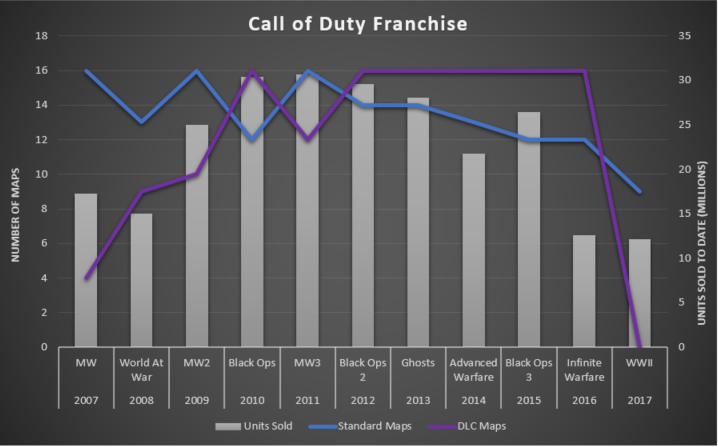The rise of DLC in AAA Games
Setting the Story:
Call of Duty: Modern Warfare was released in 2007 with sixteen standard (non-DLC) multiplayer maps, but as sequels progressed, the number of standard multiplayer maps has been steadily decreasing. In fact, in their most recent release - Call of Duty: World War II - that number hit a record low of only nine standard multiplayer maps.
Visualizing the Problem:
In the graph below, which plots standard maps, DLC maps, and units of Call of Duty games sold, it doesn’t seem like there’s a real trend or correlation between the three.
COD: WWII was recently released, explaining the dip to zero DLC maps
However, if we keep in mind that Call of Duty cycles between two developers (now three with the recent inclusion of Sledgehammer Games), and then break the data down by developer, we can see a very important finding.
Publisher: Infinity Ward
Publisher: Treyarch
The number of DLC maps has been steadily increasing, as the number of standard maps has been decreasing.
Uncovering the Truth:
Is this actually a problem? Is Activision just trying to squeeze as much money from us as possible?
The answer isn’t that straight-forward. If we look at the prices of AAA-title games, they have generally stayed at a stable $60 for decades – since the early 1990’s, in fact. But if we take into account inflation since 1990, AAA games should actually be worth almost $114 dollars now. This means that AAA games have technically halved in price, while costs for development (i.e. programmers, animators, voice actors, etc.) have technically doubled.
So, what does this mean in relation to the Call of Duty franchise (or any gaming franchise, for that matter)? One of the key reasons that Call of Duty developers aren’t creating as many standard maps is because all that extra time doesn’t produce enough extra revenue to create these games. In order to maintain the traditional $60 price tag and pay the employees a competitive salary, studios have resorted to creating DLC in order to make up for the ever-growing gap between the price of the standalone game and the costs of development.
But as long as publishers don’t abuse the DLC option like Electronic Arts did with Star Wars: Battlefront, then DLC can actually be a positive experience for players. The consistent release of DLC maps keeps the multiplayer fresh. Just looking at the number of DLC maps since 2012, Activision has consistently pushed out 16 multiplayer DLC maps per game, along with zombie maps, special ops missions, equipment, and weapon DLCs. This creates loyalty and results in more active players that ultimately culminates into a dedicated player base/following.
And it looks like Activision, for the most part, has been doing a good job of keeping their player base happy with the number of standard and DLC maps that they push out per game. Looking at the numbers, there doesn’t seem to be any correlation between the number of standard/DLC maps developed versus the amount of Call of Duty games sold.
However, with Call of Duty: World War II’s abysmal number of standard maps, there is a lot of criticism that Activision has gone too far. Unfortunately, only time will tell if Activision can compensate for the lack of base content.
